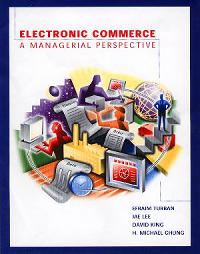
MGS 523
Seneca College, Toronto, Canada
 |
MGS 523Seneca College, Toronto, Canada |
| the link to the information
Prof. O'Neill has for the first lesson is
http://www.mhoneill.com/mgs523/l1.htm |
| . | There is a purpose
in giving you information and links to learn about the origins of the Internet
and WWW.
At the time of this course (Sept - Dec 2001) many significant changes continue to take place in the further development of the internet (eg. mobile and wireless internet) So, the purpose in
giving you information and links to learn about the origins of the Internet
and WWW is to equip you with an understanding which will help you personally
judge the immediate future events and activities so that you may be better
able, as a student and later as a business person, to evaluate particular
situations and judge whether to use, or not use, learn or not learn, spend
money or save money, as these develop.
|
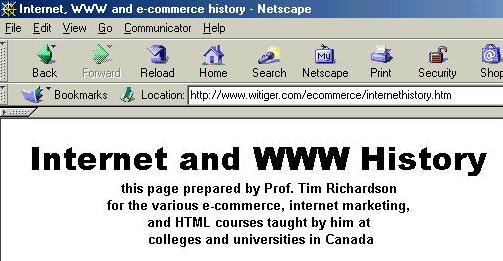

Chapter 1 |
This book by Turban et al has a publication
date listed as 2000. It was reviewed by WTGR in November 1999 and
is considered an exceptionally good book. One of the first books
to be written as a text with questions and exercises at the end of each
chapter. A companion website was operating, including the downloadable
powerpoints when last checked in March 2000.
Since the powerpoints do indeed cover much of the text in each chapter, perhaps you may be able to get away without having to purchase this particular book as long as the web site is active. You are invited to go through the .ppt for Chpt One http://www.prenhall.com/divisions/bp/app/turban/cw/ppt/ Key Points for discussion from Chapter One Interdisciplinary nature of e-Commerce (e-Business) p. 13, 14
|

Chapter 11 |
You are invited to go through the .ppt
for Chpt Eleven
http://www.prenhall.com/divisions/bp/app/turban/cw/ppt/ Chpt Eleven - Infrastructure for e-commerce Basics of a web site
TCP/IP domain names HTML and Hypertext Browsers Servers Security
Digital certificates and certificate authorities SSL and SET Firewalls |
|
Strategy
Strategy
Strategy
Strategy |
Rob Spiegel wrote story
in the Jan 26th E-Commerce Times titled
"Report: 70 Percent of Retailers Lack E-Commerce Strategy" Rob's story was based on
a new study by Deloitte and Touche that shows that while roughly one third
of retailers with a Web presence consider their online store to be
"strategic," a majority have set up Web operations with no clearly
articulated strategy and are merely "testing the waters to gauge
Internet demand."
Components of a good strategy
http://www.sob.cencol.on.ca/faculty/trichard/GNED119/Chpt8/sld010.htm see also http://www.occc.com/marketing/m-4.htm the following explanations on GOPST comes partly from www.occc.com/marketing/m-4.htm and partly from WTGR Goals--
Goals are the ultimate thing you want to achieve. They are the statements
that a company uses to motivate employees and statements used to judge
and measure challenges that you face. Excellently worded goals should include
measurable statements.
Examples:
. Examples:
(theoretically if you have the largest product offering, you have the potential to make the largest sales, which helps fulfill the goal) Plans can include such concepts as
Examples:
SWOT is an acronym that stands for
(SWOT is explained in the text in Chpt 7, page 188-189) Examples:
|
| Class
1 |
Discussed in class, the
purpose and usefulness of understanding
|
| . | SWOT - Strength Weaknesses Opportunities
Threats
Belford has some good examples "Visit the Bass Pro Shops site at www.basspro-shops.com. Sure, they have on-line shopping, but look at the many ways they attract and hold the visitor, apart from the products. The site abounds with sub-sites providing information to hunters and fishermen." .
|
| Making
your web page |
Explained fundamentals of making a webpage within Netscape Composer | ||||||||||
| Discussed
how to find information on a company with which to do your project |
Discussed in class the usefulness of accessing
the web pages of industry associations to get information on companies,
with which you could do your term projects.
It was explained that Industry Associations
contain membership lists of companies which is information you could use
to screen which companies you consider for your project.
|
| Cookies | Someone in our MGS 523 class
asked about cookies so I have added in the piece we cover in IEC 719
WTGR
|
||||||
| In traditonal marketing, we describe people
who are the first users of a new product as "innovators", then a few more
try it and we call them "early adoptors". It is important to understand
that the innovators and early adopters of a product are sometimes not representative
of the final mass group of consumers and therefore the product goes through
changes. A good example of how a product goes through changes is the case
of pocket pagers. Pocket pagers are no longer exclusively used by heart
surgeons and ambulance drivers. As the pager has become more widespread
in use among young urban people in Asia, Europe and North America it has
gone through many physical changes in appearance and services offered as
it reflects the interests of the purchasers. In the case of the internet,
innovators and early adopters of the web sites and their content were teenage
and 20/30 something men in North America. While this group still remains
a large number of people who browse sites, this demographic is growing
slower than senior aged people, people outside North America, and women
of all ages. The articles noted below serve to show how the main group
of web users has evolved to be different from the early adopters.
WTGR |
Chapter 3
 |
You are invited to go through the .ppt
for Chpt Three
http://www.prenhall.com/divisions/bp/app/turban/cw/ppt/ The purpose of this material is to focus
on the customer
|
The following graphs are from the Global Internet special report - January 2000. as used by Substance Consulting http://www.gdsourcing.com/substance/datac.htmVery Very useful page on their web site http://www.gdsourcing.com/substance/dcey1.htm Source: Ernst & Young (January, 2000 ) http://www.ey.com/global/gcr.nsf/Canada/Canada_home
Canada-US comparisons? Well, on a per household basis, we are more wired than they are (we have slightly more PCs, and slightly more of those are connected to the Internet), yet Americans are leading in using the net for buying things. There are a couple of suggestions as to
why that may be the case.
as used by Substance Consulting
|

"Canadian Internet Use Keeps Climbing" Nov 2000
|
Globe and Mail,
Report on Business article , November 17th, 2000
"Canadian Internet Use Keeps Climbing" by Guy Dixon quoting a Pricewaterhouse Coopers study this article was
online at
"Nearly half of all Canadian homes are now hooked up to the Internet, more than in either the United States or leading European countries" Dixon quotes from the Pricewaterhouse Coopers study The study says "more
than 48 per cent of Canadian households now have Internet access, up from
43 per cent last year [1999]"
Dixon explains that "Most of the growth in Canadian home Internet use this year has been due to a rapid expansion in Quebec. About 42 per cent of households in that province are now wired to the Web, up from only 29 per cent last year, as more and more French-language Web sites are created..." However, the fast
pace of the trend may be ebbing. Dixon notes that ".. for the rest
of Canada, the rate at which Internet use has grown has slowed. Fifty per
cent of Canadian homes outside of Quebec now have Internet access, up from
48 per cent last year." A rise of 2% over 12 months is quite a drop from
the fast pace of increase between 1998 and 1999.
|
.
|
|

Online shoppers in Canada The question of to what degree Canadian
business is serving the e-business community compared to American companies
|
Some Canadian e-tailers expressed discouragement
about return on their e-commerce investments by saying that too many Canadian
customers were predisposed to buying products and services from American
sites, and that Canadian sites were having to play catch-up, - which might
be very hard if a big block of consumers have already established "connections"
with US e-tailers. Is this early momentum built by American sites something
that Canadian sites will have a hard time overcoming? WTGR
Susan Pigg writing in the Toronto Star
June 17th, 2000 writes
Pigg reports in June 2000 that "In just
a year, the number of Canadian online shoppers buying from Canadian sites
has more than doubled from 28% to 58%." In the same article, Chris Ferneyhough
of polling giant Angus Reid Group
says Canadians do indeed want to be able to buy from Canadians
so this will help boost Canadian retailers. Pigg concludes her article
by saying that one of the reasons why there are more Canadians buying Canadian
sites is simply, duh, because there are more Canadian sites offering products
and services.
A couple of days before Susan Pigg wrote her article in rival newspaper the Toronto Star, Michael Petrou wrote in the Financial Post June 10th, 2000, a piece titled "Internet Shopping Still Lags in Canada" http://www.nationalpost.com/financialpost.asp?s2=eworld&f=000610/313818.html Petrou quotes from a soon to be released study by the Boston Consulting Group that says many Canadians browse sites, but few actually buy anything. Petrou also notes thatthere are a significant number (54%) who abandon an online shopping trip when they find out the U.S. e-tailer doesn't ship to Canada. Petrou added that a "study recently released by ComQuest Research Inc. reveals 61% of Canadian Internet users say they're "not very comfortable" or "not at all comfortable" with shopping online.... The same study says the number one reason Internet users don't shop online is because of security concerns." How much do Canadians buy on the internet
compared to Americans
|
||||
Chpt 3
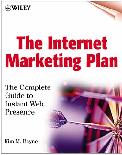 |
Internet Users by Gender
page 67 "If a well-researched study reveals that
there are now more female Internet users than ever before, this information
can be used to support a reassessment of the marketing mix and a
reallocation of advertising dollars [read promotional mix]."
"... as a result, companies who have traditionally courted the female market through television and magazines, are now courting the female market through the addition of online services and the Internet". |
| "WHO"
is using the Internet "Women" Customers |
In contemplating whether or not to include
a specific section on women and the Net there was some thought given to
the point that this might be a "non-issue" by the year 2001. That is to
say in the mid-1990's it is freely aknowledged that persons accessing the
internet were predominantly young men in North America - but by the time
the millenium broke, users have included vast numbers of people in Asia,
Europe as well as other genders so perhaps having a special section on
women and the Net might be considered patronizing.
In June 2000, Ms. Zena Olijnyk wrote and
interesting article for the National Post (which was also included in the
online version) titled
The original article was still on the National
Post's web site in August 2000
Olijnyk wrote that
"... there are differences in the
types of transactions men and women make on the Net; women tend to buy
more books, gifts and toys, while men tend to buy more computer software".
Gender Differences in Communication thought provoking page by academics about the ways men and women think differently, and subsequently interact differently online - which can allow for inferences in consumer patterns |
| In traditional marketing, we describe
people who are the first users of a new product as "innovators", then a
few more try it and we call them "early adoptors". It is important to understand
that the innovators and early adopters of a product are sometimes not representative
of the final mass group of consumers and therefore the product goes through
changes. A good example of how a product goes through changes is the case
of pocket pagers. Pocket pagers are no longer exclusively used by heart
surgeons and ambulance drivers. As the pager has become more widespread
in use among young urban people in Asia, Europe and North America it has
gone through many physical changes in appearance and services offered as
it reflects the interests of the purchasers. In the case of the internet,
innovators and early adopters of the web sites and their content were teenage
and 20/30 something men in North America. While this group still remains
a large number of people who browse sites, this demographic is growing
slower than senior aged people, people outside North America, and women
of all ages. The articles noted below serve to show how the main group
of web users has evolved to be different from the early adopters.
WTGR |
| "WHO"
is using the Internet "Women"
"WHO"
"Women"
|
- readE-shopping
trickles into mainstream, on-line article comparing Canadian and
American e-shoppers - we will discuss this in class
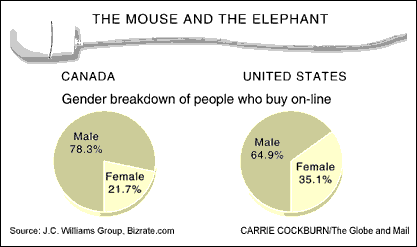 Sept
1999 Sept
1999
this chart was included in the article written by Mark Evans for the Globe and Mail in Sept 1999 Evans in turn obtained the information in this chart from the J.C. Williams Group http://www.jcwg.com/ J.C. Williams Group
http://www.jcwg.com/doubleclick-press.htm Key findings from the first wave of the Canadian Women Online Study:
|
Chpt 3
 |
Organizations and Associations
and Trade Magazines
"Many marketing and industry specific associations
offer their members reports, white papers, and research papers on trends
in new media".
|

Online shoppers in Canada 
|
On the heels of the article "Internet
Shopping Still Lags in Canada" we have a Financial Post article Sept
1st, 2000 which is titled
"Small Businesses in Canada are 69% Internet Savvy" By Vito Pilieci Leaving us to question is business doing
well, or poorly in dealing with the potential of the Internet. Different
reporters and columnists can't seem to agree.
CFIB's home page is at 
On CFIB's site, you can view the original press release at http://www.cfib.ca/mcentre/mwire/releases/tm83100.asp "Results of a national survey conducted during the second quarter of this year reveal that 69 per cent of the 9,246 small- and medium-sized businesses surveyed are now connected to the Internet – up from 61 per cent for the same period in 1999. The results also show that more than one third of small firms have entered into the arena of e-commerce. The findings are based on personal interviews conducted by the Canadian Federation of Independent Business (CFIB) in every region of the country." "CFIB’s chief economist and director of
research, Ted Mallett said: "The small business sector has been adopting
general Internet technology very rapidly during the past few years. Now
we are seeing small firms increasingly embracing more complex and sophisticated
e-business models. The most basic application is
The reason we feature the CFIB is in respect
of the fact that the fastest growing area of business (offline and online)
in the late 1990's and early millenium, is small business.
|
| Cyber
Shopping |
Kelly Mooney - Cyber Shopper
http://www.fastcompany.com/nc/001/024.html Mooney converted her findings into a personal, opinionated Internet-shopping audit: E-Commerce Analyst Watch 2.0. What can we learn about her list of do's and dont's 1. first, do we agree with her do's and dont's 2. what can we apply from the list to clients and employers you may be working with 3. Our list of Do's and Don'ts http://www.witiger.com/ecommerce/dodonot.htm
Mooney's chart is available to view on-line at http://www.fastcompany.com/nc/images/bigchart.jpg - just because it's on the Net, "don't make it so" - what is there about the chart that is useful?, and what could be explained better? Paul Graham's "The 10 Secrets of Selling Online" http://store.yahoo.com/vw/secrets.html |
| E-tailing
Considerations "Things you have to
|
Canadians from Purchasing on the Internet
Source: Ernst & Young (January, 2000
)as used by Substance Consulting
Source: Ernst & Young (January, 2000
) as used by Substance Consulting
|
| "Things you
have to be convincing about" E-tailing
"Things you
"Things you
|
List of things
you have to be convincing about
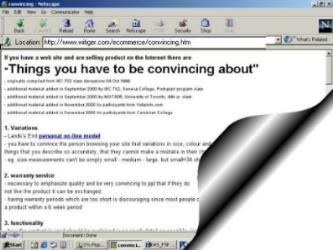
http://www.witiger.com/ecommerce/convincing.htm Most of this class will be spent discussing the "convincing.htm" list and adding on to it. 1. Variations
|

Chapter 2 |
|

Chapter 2 |
Procedure for Internet Shopping: The Consumer's
Perspective
page 55 Turban text 1. Preliminary requirement determination
2. Search for the available items
3. Compare the candidate items with multiple
perspectives
4. Place an order
5. Pay the bill
6. Receive the delivered items and inspect
them
7. Contact the vendor to get after-service
and support
(translations supplied by Witiger - no offense intended to the original author) |
| To create a web page you need
1. computer
|
To create a working e-commerce
site, you need
1. a product or service to sell
|
|
FTP Basics discussed in MGS523
FTP Basics discussed in MGS523
|
Creating a web page - to create a web
page you need .....
8. software to
send the pages to the hosting server - eg. WS FTP
One of the most popular reason why you cannot see something on a web page is because the file you are looking for, has not been properly FTP's to the server. |
||||
| Where to go to get FTP software
Where to go to get FTP software |
|
.
.